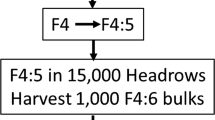Summary
Early testing was evaluated for efficiency as a procedure for selecting among lines for yield (total and marketable fruit number), earliness and fruit quality (shape, color and seedcell size) in 24 sets of lines developed at random from a pickling cucumber (Cucumis sativus L.) population. The advantage of early testing was calculated using the regression of S6 on S1 performance. The amount of effort required in worker-hours and the theoretical gain from selection were also considered in estimating the advantage of early testing. Early testing for specific combining ability and for general combining ability was up to 2.05 times as efficient as late testing for total yield, and up to 2.29 times as efficient as late testing for earliness. Early testing was not efficient for selection for the fruit quality traits measured, nor for inbred performance per se.
Similar content being viewed by others
References
Hallauer, A. R. & E., Lopez-Perez, 1979. Comparisons among testers for evaluating lines of corn. Proc. Annu. Hybrid Corn Ind. Res. Conf. 34: 57–75.
Hallauer, A. R. & J. B., Miranda, 1981. Quantitative genetics in maize breeding. Iowa State University Press, Ames, Iowa.
Jenkins, M. T., 1935. The effect of inbreeding and of selection within inbred lines of maize upon the hybrids made after successive generations of selfing. Iowa State College J. Sci. 3: 429–450.
Lonnquist, J. H., 1950. The effect of selection for combining ability within segregating lines of corn. Agron. J. 42: 503–508.
Miller, C. H. & G. R., Hughes, 1969. Harvest indices for pickling cucumbers in once-over harvested systems. J. Amer. Soc. Hort. Sci. 94: 485–487.
Richey, F. D., 1945. Isolating better foundation inbreds for use in corn hybrids. Genetics 30: 455–471.
Richey, F. D., 1947. Corn breeding: gamete selection, the Oenothera method, and related miscellany. J. Amer. Soc. Agron. 39: 403–412.
Smith, O. S., R. L., Lower & R. H., Moll, 1978. Estimates of heritabilities and variance components in pickling cucumber. J. Amer. Soc. Hort. Sci. 103: 222–225.
Sprague, G. F., 1946. Early testing of inbred lines of corn. J. Amer. Soc. Agron. 38: 108–117.
Wehner, T. C., T. J., Monaco & A. R., Bonnano, 1984. Chemical defoliation of cucumber vines for simulation of once-over harvest in small-plot yield trials. HortScience 19: 671–673.
Wehner, T. C. & W. H., Swallow, 1984. Optimum plot size for once-over harvest of pickling and fresh-market cucumbers. Cucurbit Genet. Coop. Rpt. 7: 35–36.
Author information
Authors and Affiliations
Rights and permissions
About this article
Cite this article
Rubino, D.B., Wehner, T.C. Efficiency of early generation testing in pickling cucumber. Euphytica 35, 89–96 (1986). https://doi.org/10.1007/BF00028545
Received:
Issue Date:
DOI: https://doi.org/10.1007/BF00028545




